The navy of Myanmar (formerly Burma) is not well studied and prior to the mid-2000s, did not really amount to much. Three warships from WWII served on for decades in the Burmese navy and as of 2020, two still were.

(UMS Yan Gyi Aung – USS Creddock (MSF-356) during WWII – fires a gun salute in December 2019.)

(UMS Yan Tuang Aung – USS Farmington (PCE-894) during WWII – in service in the late 2010s.) (photo via Radio Free Asia)
WWII in Burma
What is today Myanmar was annexed by Great Britain in 1886 as part of Raj India. In 1937, Burma was detached from Raj India into a separate colony.
British Burma took a terrible pounding during WWII. Japan opened the colony as a new war front in early December 1941 including a massive bombing raid against Rangoon on Christmas Eve. By mid-1942, Japan had occupied the whole territory, pushing onwards into western Raj India.
In late 1943 the Allies pushed the CBI front back into northern Burma, and also bombed the occupied colony from the air. By mid-1945 more than half the colony had been liberated by the Allies and the Japanese front was rapidly collapsing. WWII ended on 2 September 1945.
birth of the Burmese navy
Just prior to WWII, a “Burma Royal Navy Volunteer Reserve” had been formed as part of the Royal Navy’s commonwealth scheme. The force had few ships and none of any importance, few men, and played no appreciable part in WWII.
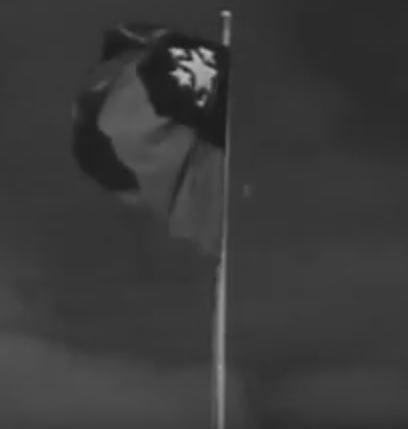
(Burma’s flag at independence. The country has changed its flag four times since WWII, most recently in 2009.)
In 1947 the British parliament conferred future independence to Burma. As part of this process, several WWII-veteran warships were transferred from the Royal Navy: the frigate HMS Fal, renamed HMBS Mayu, and four WWII LCG(M)s or medium gun landing craft. Despite their name they had ship-type bows and were intended to support amphibious assaults with gunfire, rather than landing any troops themselves. To that end they had a pair of 25-Pounder howitzers set in naval style turrets.
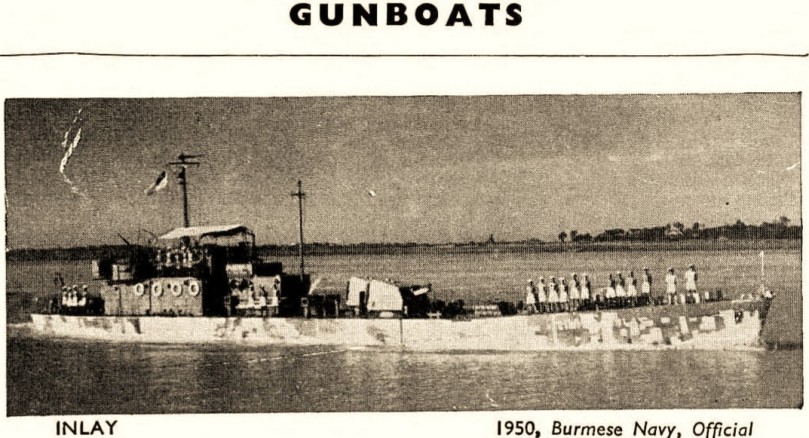
(UBS Inlay in the 1950s.)
For the new Burmese navy these were ideal counter-insurgency ships as their shallow draught allowed navigation up rivers to support army operations. These four WWII ships (HMBS Indaw, HMBS Inlay, HMBS Inma, and HMBS Inya) served the Burmese navy into the late 1970s, the last of their kind worldwide. Although less glamorous than the flagship UBS Mayu, they were equally or maybe more useful.
On 4 January 1948 Burma became fully independent, with naval ships now prefixed Union Of Burma Ship or UBS. UBS Mayu fired a gun salute along with the WWII cruiser HMS Birmingham, which embarked the last colonial governor as British rule ended.
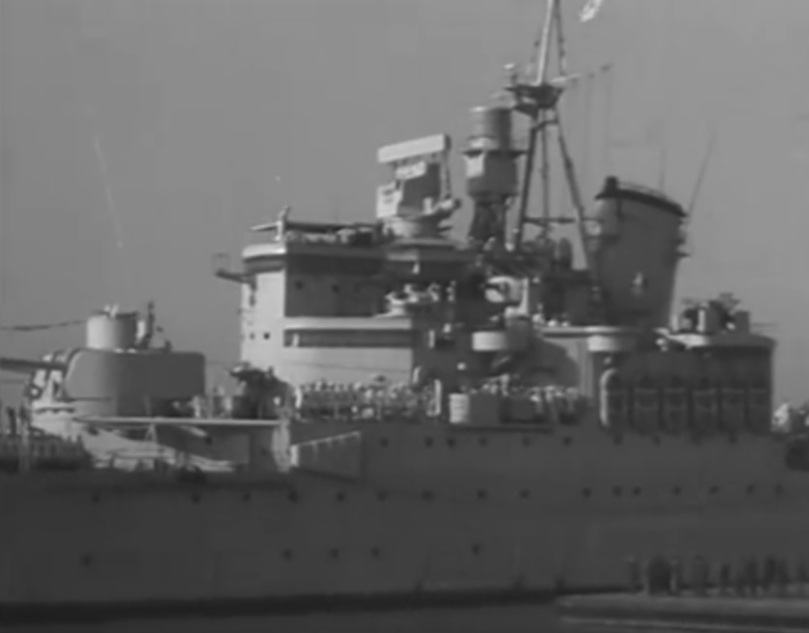
(HMS Birmingham departs Burma for a final time in 1948. This WWII cruiser remained in RN service until 1959.)
For the new country, a navy was not a high priority as Burma / Myanmar (the name changed in 1989) has been wracked by internal fighting. There have been, or still are, four ethnicity-based armed conflicts (the most serious being the Karen group, which has been fighting for freedom since the Japanese occupation during WWII), a muslim separatist insurgency, a communist faction during the early part of the Cold War, several coups, and perhaps most oddly a nationalist Chinese army which became marooned along the Burmese-Chinese border when Chiang Kai-shek fled the mainland in 1949.
In April 1958 the ex-HMS Mariner, a WWII Royal Navy patrol minesweeper, was recommissioned as UBS Yang Myo Aung. The ship itself was free but Burma bore the cost of reactivating UBS Yang Myo Aung after several years in British mothballs.
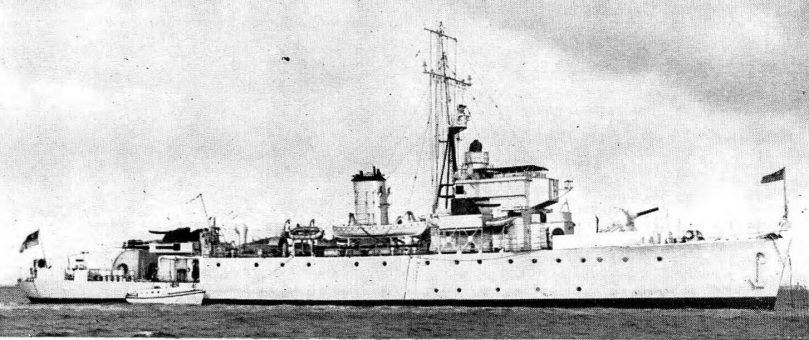
(UBS Yang Myo Aung, the former HMS Mariner of WWII, in 1958.)
UBS Yang Myo Aung served on until 1982. Other than the aforementioned UBS Mayu, the only other major WWII-surplus ships acquired were the two American ships described below.
part I: UBS Mayu
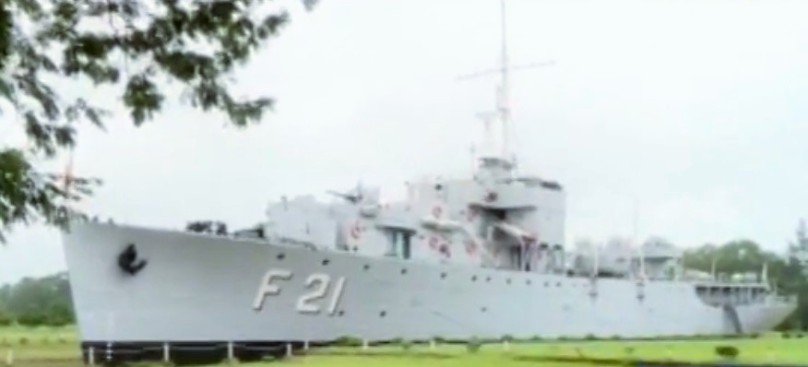
what was the River class
During the first part of WWII, the British shipwright William Reed proposed for Smith’s Dock Company a type of anti-submarine warfare (ASW) ship to escort convoys, which would have many of the Black Swan class’s ASW potential but the ability to be built faster, cheaper, and in less sophisticated shipyards.
Part of this “simplification” was the propulsion, which used reciprocating steam engines instead of geared steam turbines. The River class had two reciprocating engines powered by two boilers turning two shafts with 3-bladed propellers. With this, they were limited to about 19¾ kts which was at least a third slower than contemporary GST-powered frigates. This was considered acceptable as an escort was limited by the slowest merchant ship in the convoy anyways.
The main ASW armament was a Hedgehog Mk.I (the same weapon as the US Navy’s Hedgehog).
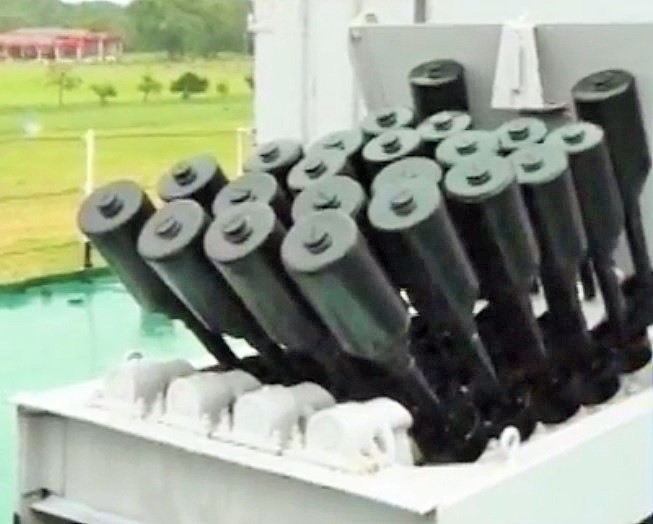
(UBS Mayu’s Hedgehog.)
Often incorrectly described as a “rocket launcher”, the Hedgehog was technically a 24-round spigot mortar. Each projectile weighed 65 lbs of which about half was Torpex high explosive. The Hedgehog was fired in a dozen pairs in very rapid sequence, creating a “fan” 200yds ahead of the frigate which sank rapidly (100′ every 4½ seconds).
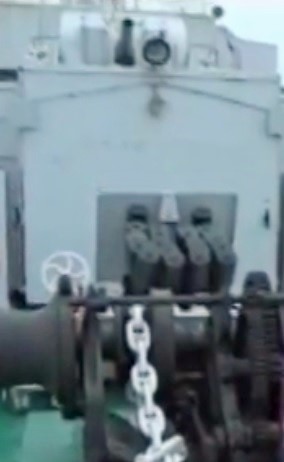
(The Hedgehog on UBS Mayu, sited behind the anchor windlass on the weather deck below and ahead of the main gun.)
Compared to a normal stern-rack depth charge, the Hedgehog’s advantages were numerous. The most obvious was that the frigate did not need to cross over the targeted u-boat’s position to attack it. Beyond that, the “fan” of descending projectiles increased the odds of a hit and the projectiles themselves did not detonate except by direct impact, meaning sonar was not blanked out by the noise of an unsuccessful run.
The River class’s other ASW armament was two traditional stern depth charge racks and four Mk.IV depth charge throwers. Similar to the US Navy’s more famous Mk6 K-Gun, the British Mk.IV projected a single Mk.VII depth charge between 50 – 67yds away.
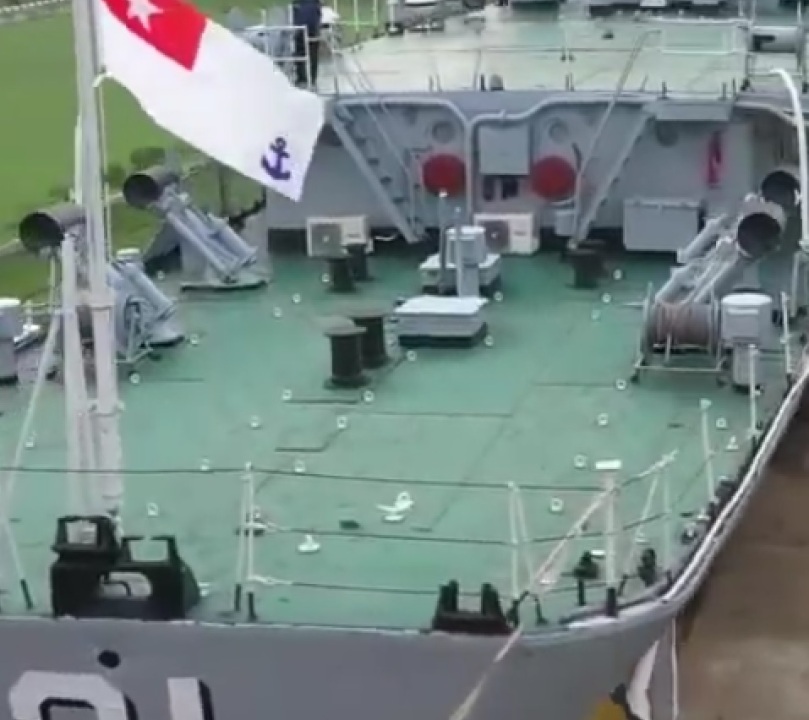
(The Mk.IV depth charge throwers aboard UBS Mayu. These had actually been removed during the warship’s latter Burmese career, warehoused ashore, and were then reinstalled when the frigate was retired and moved ashore. During WWII there would have been reload racks and handling posts as well, which were not reinstalled. The astern depth charge racks were also not reinstalled. This also shows the current (2020) Myanmar navy ensign which has changed multiple times.)
The River class was not really intended for battle against other surface warships but none the less had to have some ability. The main gun armament was two QF Mk.XIX 4″ guns, one forward and one aft.
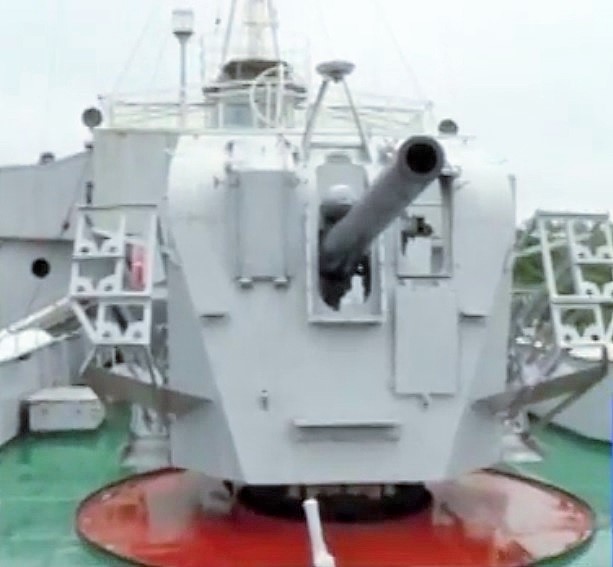
(The forward QF Mk.XIX aboard UBS Mayu. The lattice structures are launchers for illumination rockets.)
This was not a particularly great WWII naval gun, but it was not terrible either and most importantly, it was inexpensive and not time-consuming to train on. The QF Mk.XIX’s 35 lbs 4″ shell only had a range of 4½ – 4¾ NM. It had a low (1,300fps) muzzle velocity and very limited anti-aircraft ability. This gun was semi-enclosed by an open-backed gunshield that only provided protection against shrapnel. The QF Mk.XIX was hand-loaded, visually-aimed, and rotated and elevated manually by handwheels.
The weapons fit was rounded out by ten 20mm AA guns (when HMS Fal transferred to Burma after WWII, this had already been reduced to eight).
The River class was equipped with a Type 271 radar, a HF/DF radio-direction finder, and Type 144 and Type 147B Sword sonars. The Type 144 was just a general-purpose ASW sonar while the Sword was a special high-frequency active sonar which transmitted broad horizontally but narrow vertically (like the swing of a sword), and could maintain track on a u-boat during a Hedgehog attack.
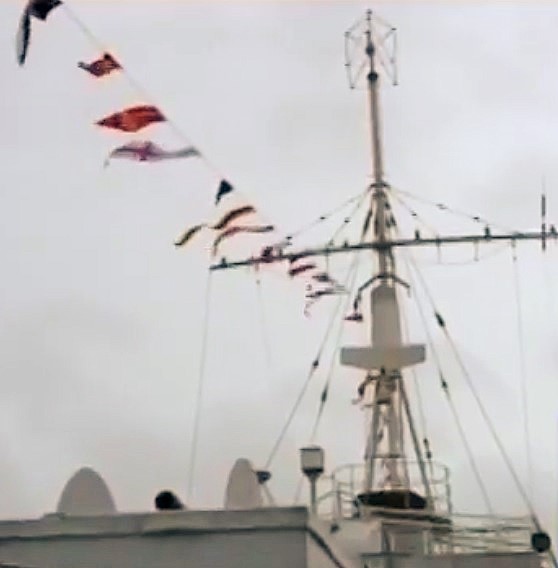
(The HF/DF set from WWII remained aboard UBS Mayu the ship’s entire career. The radar in this photo is an I-band navigation set added later in Burma after the WWII Type 271 became inoperable.)
As designed during WWII, the River class displaced 1,370t standard and 1,830t full. They measured 301’4″x36’6″x13′. The WWII manning was 107 officers and enlisted.
A total of 151 River class frigates were built and they were widely exported after WWII. In addition to the Royal Navy and Royal Canadian Navy, twenty different navies (including Burma) operated these warships.
HMS Fal during WWII
HMS Fal commissioned on 2 July 1943. During WWII the frigate escorted convoys mostly off western Africa, not sinking any u-boats and taking no damage. After Germany’s surrender in May 1945 HMS Fal was not selected for participation against Japan and instead, trained the rebuilding French navy on ASW.
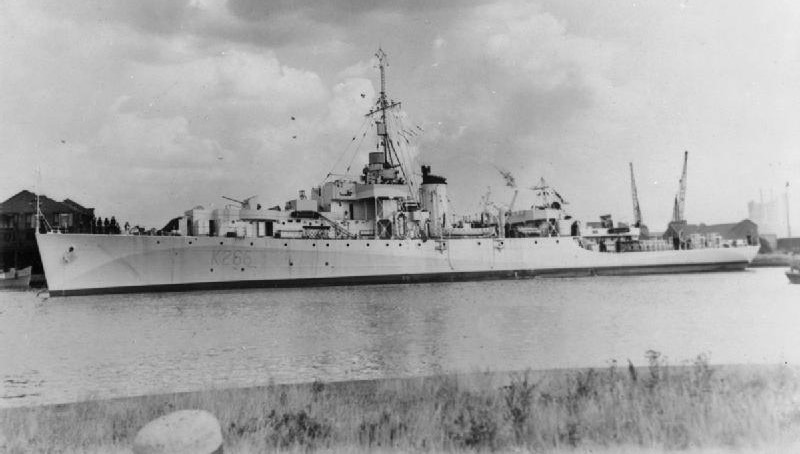
(HMS Fal – the future UBS Mayu – serving in the Royal Navy during WWII.) (Imperial War Museum photo)
In 1946 HMS Fal was visiting Dakar, French West Africa (today Senegal) when one of the frigate’s propellers became snarled in a steel cable. After repairs in South Africa, HMS Fal was ordered to southeast Asia for transfer to the Burmese as outlined earlier above.
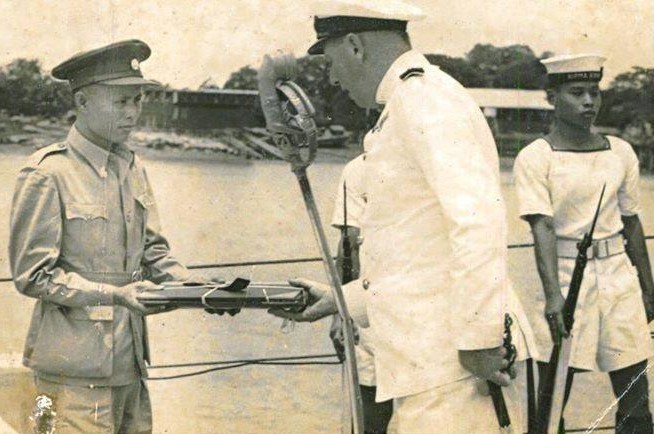
(A British officer presents the logs to General Aung San as the ship officially becomes Burmese property. The WWII Enfield No.4 Mk.I rifle remained in Burmese military use until the early 1960s and in 2020 is still used by police in Myanmar.)
in service
For UBS Mayu, there was no “honeymoon period” as the frigate was needed for combat operations almost immediately. The ship regularly supported the army fighting ashore throughout the late 1940s and the 1950s.
Battle of Insein: During 1948 – 1949 Karen troops made a very bold move to gain their independence by attacking Rangoon, the then-capital of the brand new country, and winning their own region’s freedom by simply ousting the entire national government.
The Karens made it as far as Insein; today a northern suburb of Yangon but then a town about 20 miles north of Rangoon.
UBS Mayu advanced upstream about 2½ NM on Rangoon’s west side, roughly where modern Yangon’s Kyi Mine Dine neighborhood is today, and provided gunfire support for the ashore fighting. This was a fairly bold use of a frigate designed for open-ocean combat, as the river is only about 800′ wide and not much deeper than UBS Mayu‘s own draught. UBS Mayu anchored against the current and fired 4″ rounds howitzer style several miles inland. The city was successfully defended.
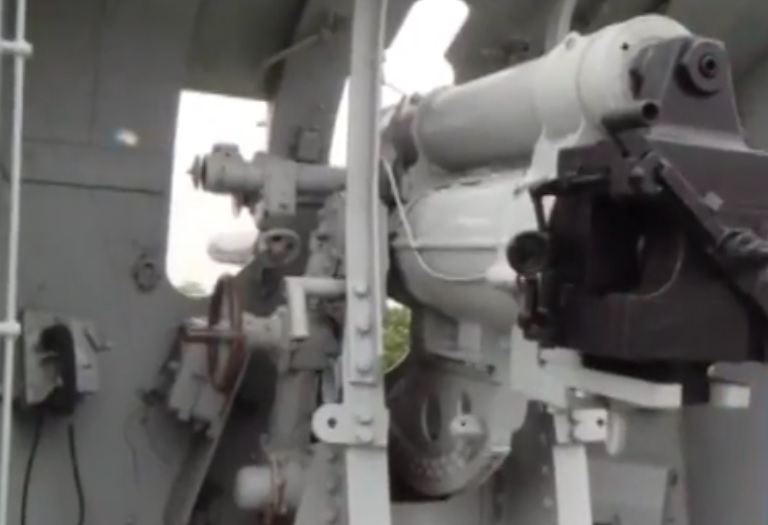
(The breech and elevation assembly of UBS Mayu’s forward 4″ gun, never altered from WWII.)
Pathein campaign: Pathein is city of the Irrawaddy delta on Myanmar’s southern coastal seaboard, about 80 miles overland due west of Yangon and about 200 NM sailing distance. In 1948, anti-government rebels were occupying fortifications left over from WWII and proved impossible to dislodge from land. The rebels were defeated with the help of offshore gunfire from UBS Mayu.
Mawlamyine campaign: One of Burma’s numerous ethnic insurgencies was the Mon, who are concentrated in the panhandle region. In 1949 these insurgents overran Mawlamyine (about 99 NM sailing distance from UBS Mayu‘s homeport of Rangoon), the country’s fourth-largest city and at the time, its second-largest trade port. UBS Mayu provided gunfire support and a radio link for troops which retook the city.
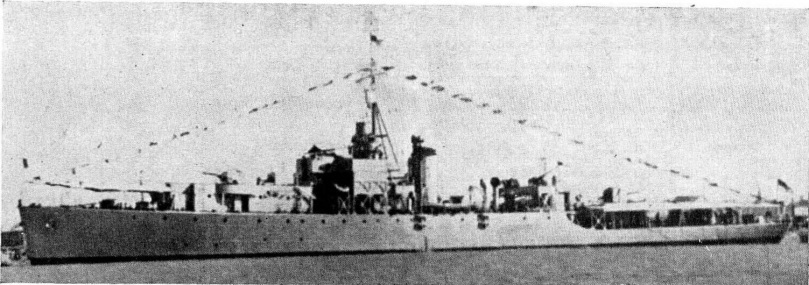
(UBS Mayu in 1954, still little altered from WWII. The canvas sunscreen on the quarterdeck was often used in hot Burma, as UBS Mayu was not air-conditioned.)
the Red Flag campaign: During the early 1960s Burma’s Rakhine coast (the northwest seaboard up to the border with Bangladesh, at that time East Pakistan) had two simultaneous problems: a muslim separatist issue and the Burma Red Flag communists, also called Thakin Soe after their leader. In 1962, UBS Mayu led an amphibious assault to outflank the Red Flag forces near Sittwe. This was the most complex operation the WWII-vintage frigate participated in and also the actual combat most distant from the ship’s homeport.
UBS Mayu also undertook non-combat missions. The ship “showed the flag” of the new country with friendship visits to Singapore (multiple times during the late 1940s / early 1950s), Sri Lanka in 1955, Australia in 1959, Indonesia in 1960, and India in 1960 and 1961. During the late 1940s, UBS Mayu also trained the first Burmese civilian mariners until a proper merchant marine academy was up and running. During the 1960s and early 1970s, the frigate was used in counter-smuggling operations.
UBS Mayu‘s 1959 visit to Australia, a return for a port call by HMAS Quiberon to Rangoon, was the first time a Burmese warship had visited another continent. It was supposed to be the start of naval training ties between the two countries. However it was never followed up with, and that whole project ended in 1965 when the defense attache in Canberra defected and was not replaced. UBS Mayu never again left Asia.
changes in service
UBS Mayu‘s combat ability was never enhanced in Burma, but rather it was a case of one thing after another falling out of service as the decades after WWII went on.
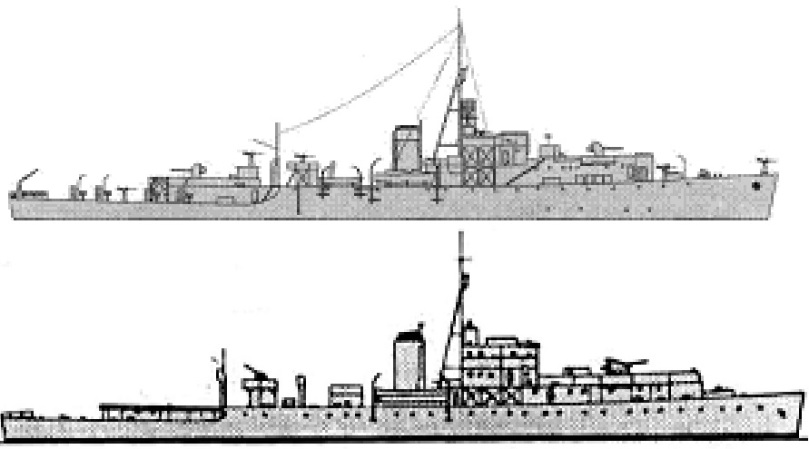
(Comparison line drawings of UBS Mayu in the late 1940s vs late 1970s.) (artwork via navypedia website)
The sonars were inoperable by the late 1960s. The depth charge racks and four depth charge throwers were removed. The Hedgehog was left aboard however there was now no way to target it other than dumb luck, and it may have been left inoperable.
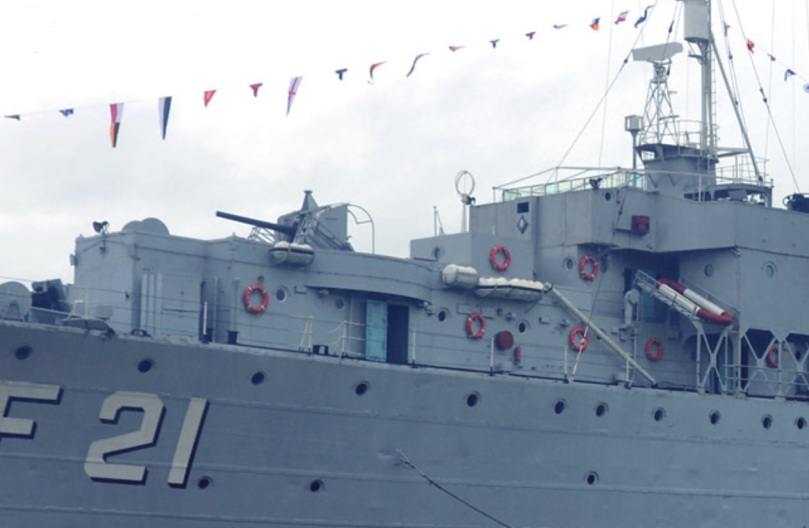 (A view of UBS Mayu showing the main gun and replacement radar. The modern self-inflating liferaft capsules were one of the few upgrades the ship received.)
(A view of UBS Mayu showing the main gun and replacement radar. The modern self-inflating liferaft capsules were one of the few upgrades the ship received.)
The WWII British radar eventually became inoperable and was replaced by a simple I-band radar, which at least allowed the UBS Mayu to safely operate at night. As an economy measure four of the eight AA guns were removed to reduce the manning level of the ship.
At some point in the early 1970s, the aft 4″ gun was removed and the entire quarterdeck rear of the funnel was reconfigured, extended, and strengthened to take the weight of a small naval helicopter.
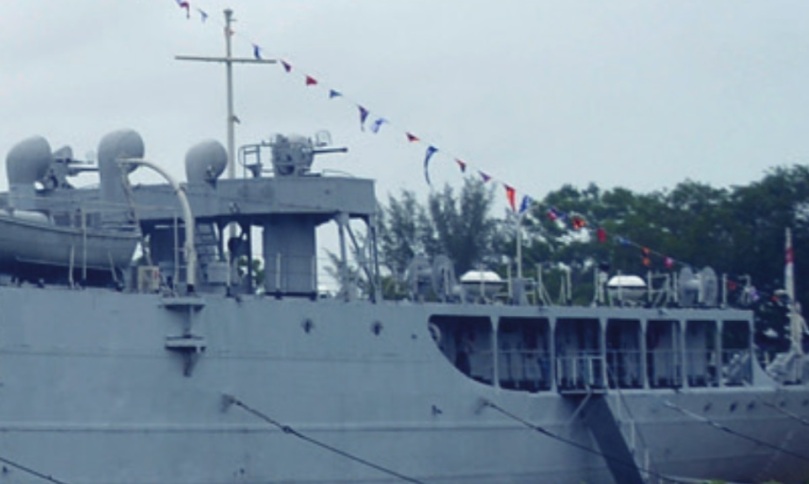
(The would-be helipad and the new 40mm AA positions. The four “ears” to the left are uptakes for the propulsion and below-decks ventilation.)
The planned naval helicopters were never acquired (although one Burmese veteran recounted that a helicopter of some sort did make at least one successful test landing on UBS Mayu) and the whole effort was essentially a waste. The aft 4″ gun was not replaced however four 40mm single AA guns were installed, replacing the removed 20mms.
the move ashore
By early 1979 UBS Mayu was thoroughly worn out. The boiler tubes dated back to WWII and were near or at the end of their lives. The electrical distribution bus feeding lower decks failed, meaning sailors had to use battle lanterns in those areas for lighting.
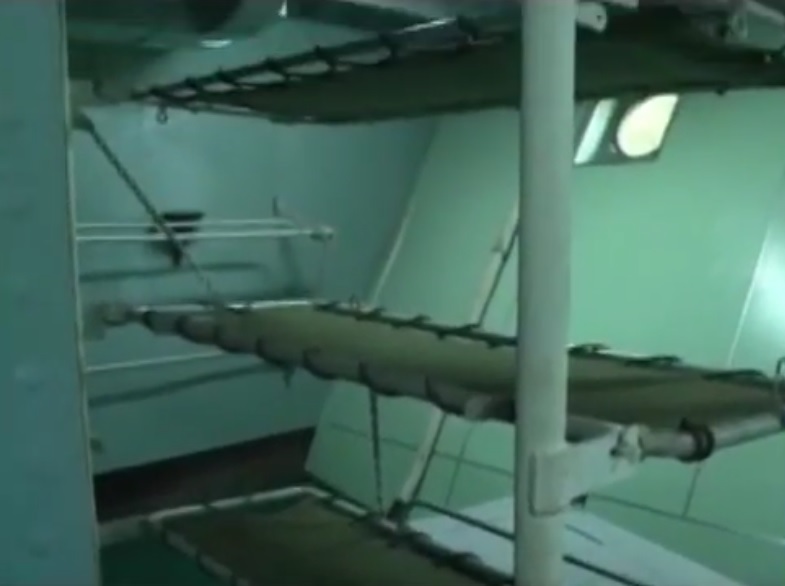
(The enlisted berthing aboard UBS Mayu was never altered from the WWII Royal Navy standard.)
During a 1979 conference of army, air force, and navy officers it was decided to decommission UBS Mayu as the frigate was by now woefully obsolete and presented a wasteful use of maintenance funds. On 28 September 1979, UBS Mayu decommissioned.
It was planned to scrap the ship in Yangon however shortly after decommissioning Dr. Maung Maung, a future president of Myanmar but then chief legal justice to Ne Win’s government, requested a tour of the WWII ship. Afterwards Dr. Maung suggested that instead of being scrapped, UBS Mayu should be converted into a museum ship. Funding for this was approved later in 1979.
In 1980 UBS Mayu was shoved up into a muddy nook on the east bank of the Bago river, about 3 NM downriver from downtown Yangon. This in itself was not unusual; even today in the 2020s it is normal in Yangon for barges or sampans to be stored via finding a flat break or crevice in the riverbank, grounding the vessel, and then gliding it across soft mud away from the river.
For several years UBS Mayu sat this way, cordoned off by a barbed wire fence and slowly rusting away. During the 1980s a proper ashore position was built.
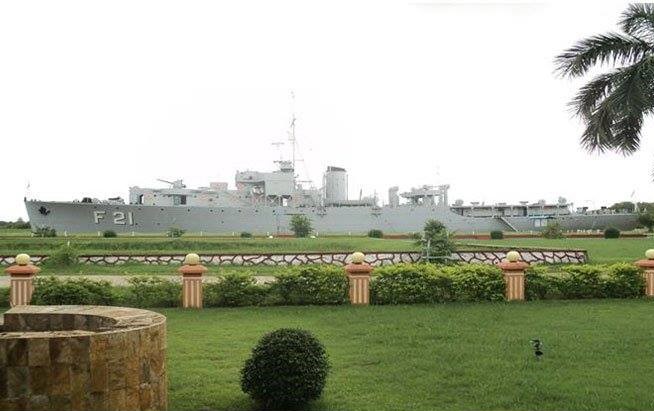
Considering the economic woes of the country at the time, the effort was elaborate and the final product is actually quite nice. UBS Mayu sits in a depressed paved basin which self-drains. The ship is now wired into ashore electricity and fitted with a dehumidification system.
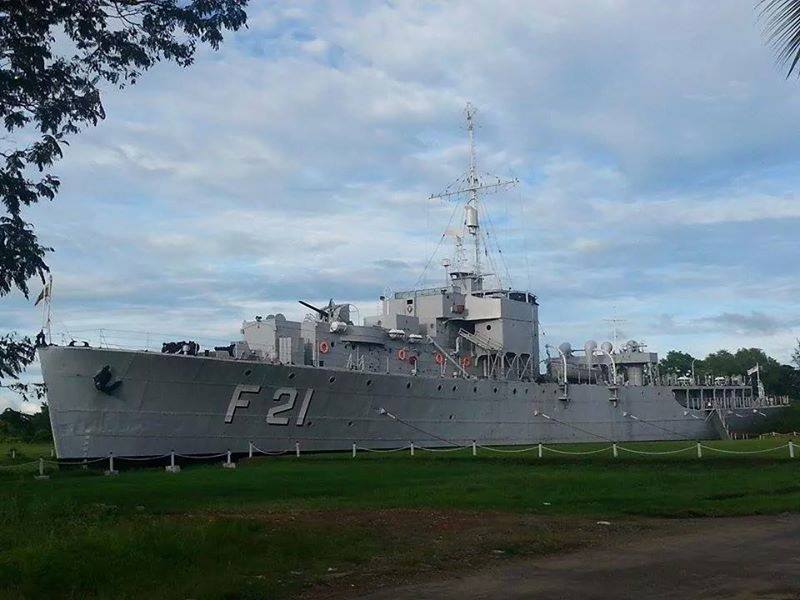
(The permanently-grounded UBS Mayu in 2014.)
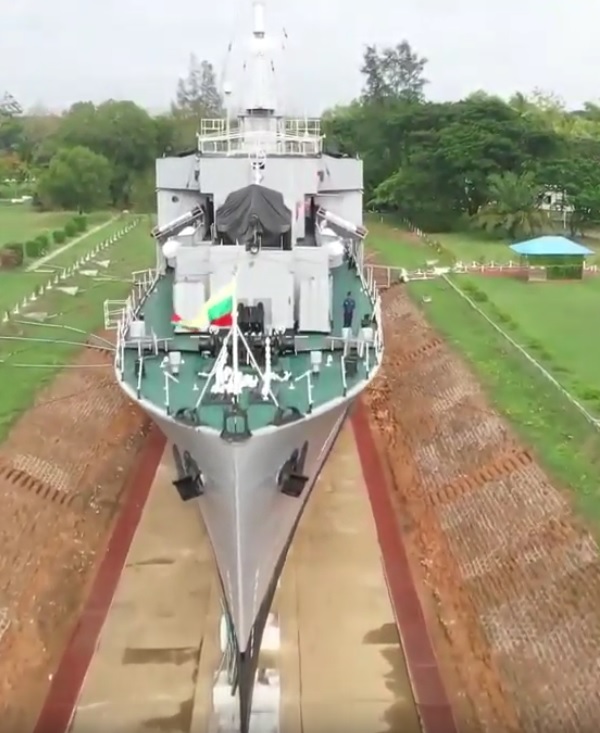
(The above view is from a 2018 airing of the Russian tv show Zvezda which toured UBS Mayu and shows the basin.)
The existence of this WWII ship at all is not widely-known worldwide, and when it is, the location is usually wrong. It is not at the Thanlyin Naval Base but rather a small, standalone facility 2 miles upriver called DCS which is about 3 miles from downtown Yangon.
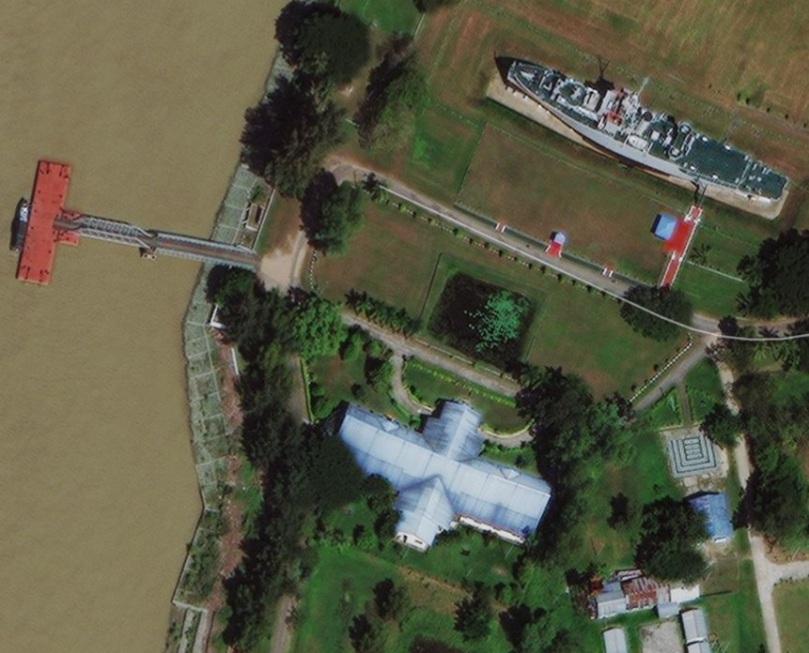
(UBS Mayu at the DCS facility in 2020.)
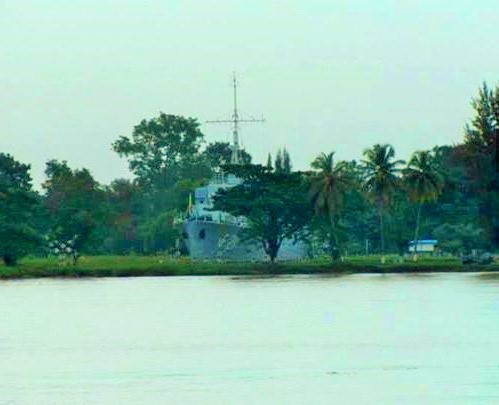
(The permanently-landed UBS Mayu as seen from the Bago river in 2014.)
The DCS facility conducts specialized niche training in fields like navigation, etc. Here in its new home, it is not completely accurate to describe UBS Mayu as a “museum ship”. For one, it is generally not accessible. Civilians were not allowed on at all during the 1980s and part of the 1990s, and thereafter civilian tours are generally limited to holidays or prearranged groups. The ship is more accessible to media, political VIPs, foreign dignitaries, etc.
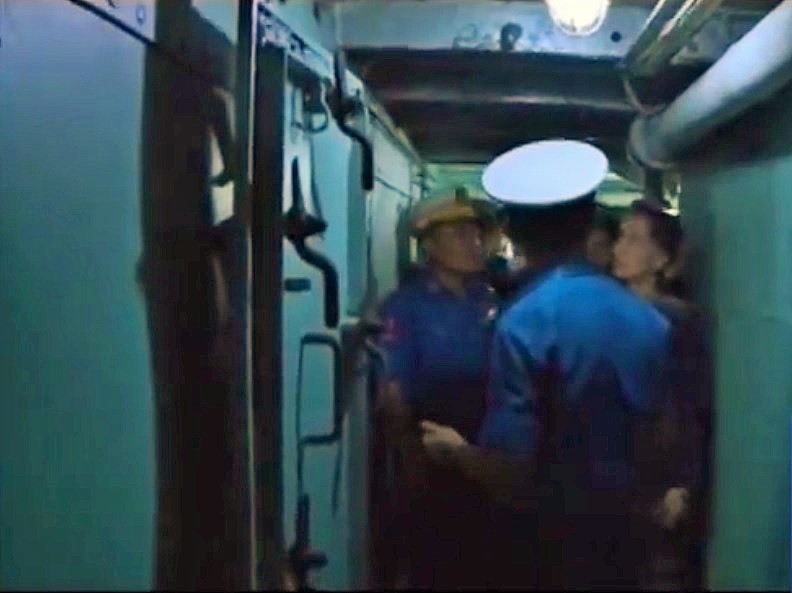
(A political VIP being given a tour of UBS Mayu during 2018.)
The other factor is that even now in a permanently ashore state, UBS Mayu continues to provide some residual use to Myanmar’s navy. At the DCS facility, the frigate was, for a while anyways, used to simulate a shipboard environment for officers undergoing training there. It was also used for ceremonies like officer commissionings, re-enlistments, etc. During the 1990s and 2000s, when the SPDC military government exhibited paranoia regarding supposed foreign attack plots, the navy was hesitant to showcase its technology or readiness levels and UBS Mayu was used as a “stand-in” for news reports or recruitment ads requiring internal looks at a warship, with stock footage of the actual warship in question’s external appearance then being spliced in.
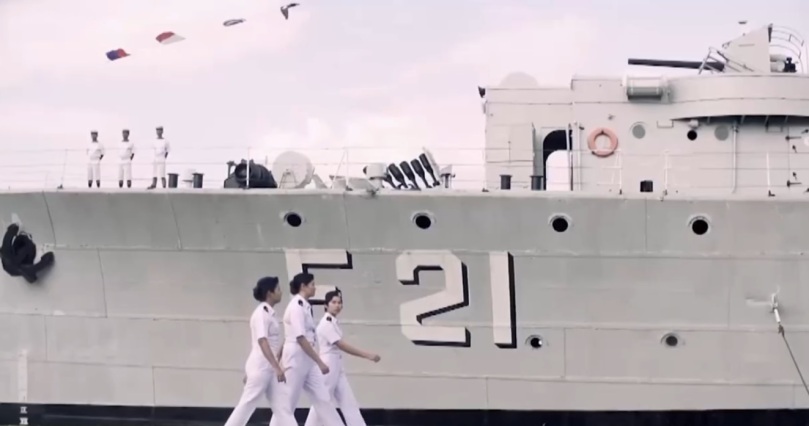
(Scene from a state-funded navy documentary video which shows UBS Mayu as if the ship was still operational. This does give a good look at the WWII Hedgehog and 4″ gun.)
Since the 2015 election, there has been a bit more openness in the Myanmar military and it is possible that access to this WWII veteran warship will be increased in the future.
As an interesting final note, in 2009 the navy’s prefix changed to “Union of Myanmar Ship” or UMS; however the change was not retroactively applied to UBS Mayu out of respect to the frigate’s historical importance.
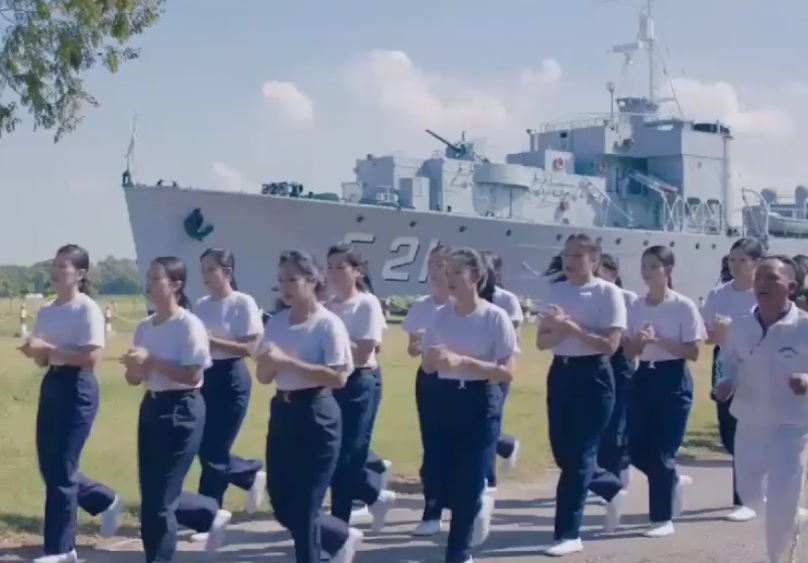
(Female officer candidates run PT past UBS Mayu in 2020.)
part II: the WWII American warships
There are two ex-US Navy WWII warships still in the Myanmar navy in 2020: UMS Yan Tuang Aung (41), formerly USS Farmington (PCE-894) a PCE-842 class escort and UMS Yan Gyi Aung (42), formerly USS Creddock (MSF-356) an Admirable class minesweeper.
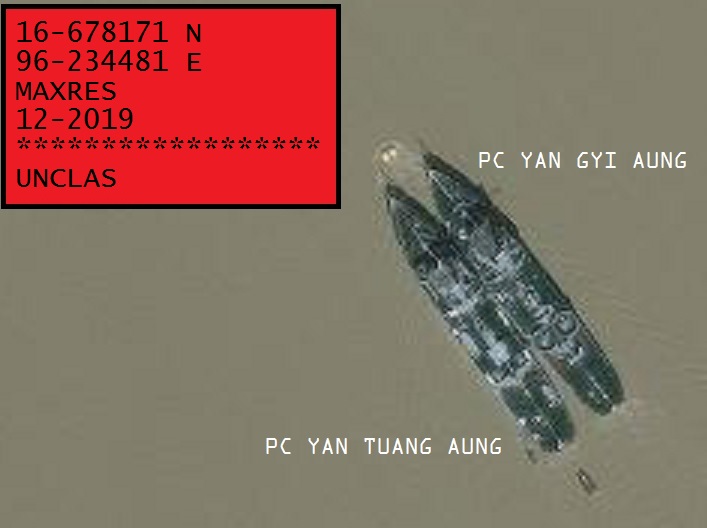
what was the Admirable class
During WWII the United States ordered 147 of these minesweepers, of which only 123 were actually completed. The first, USS Admirable (MSF-136) commissioned on 20 April 1943. The last completed, USS Harrier (MSF-366), commissioned in October 1945, eight weeks after WWII had already ended.
The class was originally typed as “minesweeper, general-purpose, coastal subcategory” (AMc-___) then just general-purpose minesweeper (AM-___) and finally fleet minesweeper (MSF-___).
These ships were intended to follow battle fleets directly across long expanses of ocean and support them with minesweeping, either in deep or coastal waters. The Admirable class measured 184’6″x33’x9’9″ and displaced 650 tons standard and 945 tons maximum full. As designed during WWII the crew was 104.
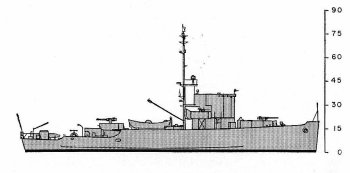
During WWII, the expectations of minesweepers was different than today, and it was considered likely that they would come under attack themselves, and would also be expected to perform patrol duties when not sweeping mines. The specified WWII armament was a single 3″ Mk21 gun and a Mk11 Hedgehog forward, two Mk2 twin 40mm AA guns aft, and boltdown attachments for optional depth charge racks. As WWII went on, this was often enhanced, and some also ended up carrying six 20mm guns and four Mk6 K-Gun depth charge throwers.
The class was equipped with a Type SU radar and a QCU simple sonar.
The Admirable class used paravanes and cutting cables to destroy moored contact mines. As these were steel-hulled minesweepers they were unsuitable for sweeping magnetic mines. The tradeoff to that was that they had excellent endurance (for example, they could sail from Norfolk, VA to London at a steady 10¼ kts without refueling) and they were strongly-built ships that could ride out open-ocean storms.
what was the PCE-842 class
These were Admirable class hulls simply modified to be general-purpose combat ships, with the minesweeping equipment replaced by additional weapons.
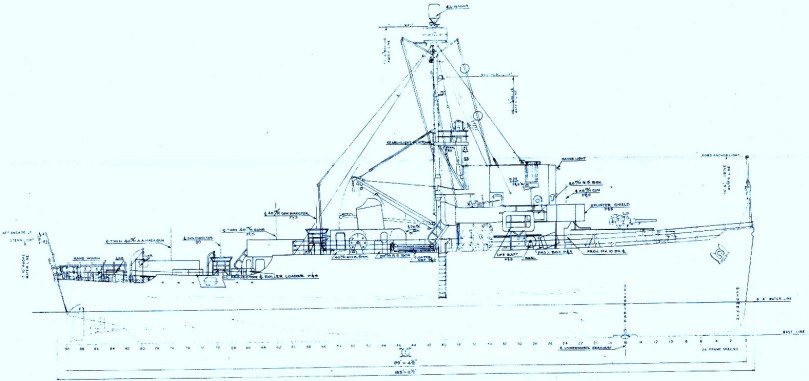
This class came about early in WWII as the result of concerns about an unrelated type, the Bluffton class subchasers. The US Navy predicted that class 1) would be critically important in the u-boat war 2) would take heavy losses in combat, and 3) would experience production delays. As WWII played out, all three assumptions were wrong. But in any case in 1942 that was the thinking. It was decided to adapt the existing Admirable class blueprints for general combat duties.
The emphasis of this class was getting warships built as fast as possible in as many places as possible; preferably minor shipyards (including on the Great Lakes) to free up larger shipbuilders for larger types. To this end, both the Admirable and PCE-842 classes had “wiggle room” in their designs: the two diesel engines could be ALCO 539s, General Motors 12-278s, Cooper-Bessmer GSB-8s, or Busch-Sulzer 539s. The reduction gearings could be from Farrel-Birmingham, Falk, or National Supply Company. The emphasis was on not having one particular subcontractor delay a ship due to a production bottleneck down the supply stream. Other things aboard (pumps, electrical buses, etc) were the same way.
Because of the many possible “mix & match” engine / reduction gear combinations above, the top speeds varied but were never great – as low as 14 kts and up to 15¾ kts. For the Admirable class, speed was essentially irrelevant as (obviously) minesweeping is an art best not rushed. For the PCE-842s, there was nothing that could be done about it.

(Both the Admirable minesweepers and their PCE half-sisters (shown above) were bigger above the waterline than below, and laid out somewhat unusually. The starboard engine was just behind and below the bridge, and powered its propeller via a driveshaft that ran half of the vessel’s length.)
With no need for minesweeping gear the PCEs were armed with a forward open single 3″ or 5″ gun of whatever type was readily available (usually the Mk21 3″, same as the Admirables), four Mk2 twin 40mm AA guns, four single or twin 20mm guns, a Mk11 Hedgehog, two Mk3 astern depth charge racks each holding eight depth charges for ready-use, and two or four Mk6 K-gun depth charge projectors.
This fit was not ironclad and shipyards were instructed not to hold up a vessel for supply delays in one weapon.
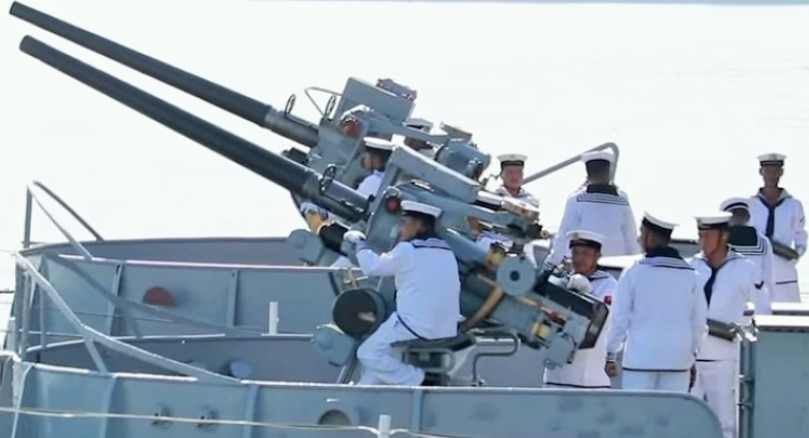
(The WWII-vintage Mk21 3″ guns of UMS Yan Tuang Aung and UMS Yan Gyi Aung in 2019.)
The Mk21 gun (officially in the WWII nomenclature: Gun, 3″, Mk21 on Mount Mk26) was a common American WWII weapon. It could fire Mk29 AP, Mk27 or Mk31 AA, or Mk25 illumination rounds, each weighing 13 lbs with a 2,700fps muzzle velocity. The range was 4,500yds in direct fire or 7 NM in plunging fire.
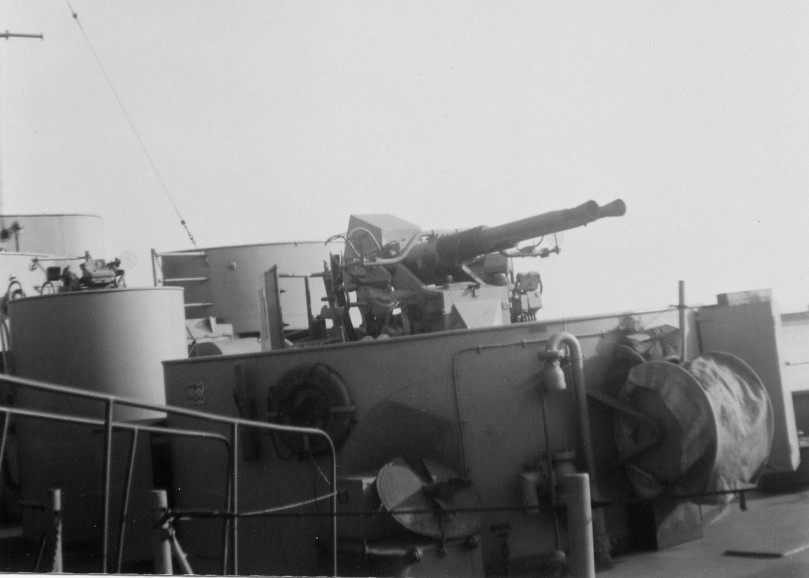
(Mk2 40mm aboard USS Farmington (PCE-894) – the future UMS Yan Tuang Aung – during WWII.)
The US Navy’s Mk2 40mm gun, in either twin or quad mountings, was the best naval AA gun of WWII. The rate of fire was theoretically 140rpm but the need to keep it fed with fresh clips realistically reduced this to 90rpm. The 1.9 lbs projectile had a high (2,890fps) muzzle velocity.

When both ships transferred to Burma in the 1960s, they had AN/QCU-2 sonars, the final variation of the WWII QCU set. This was as basic as a sonar could possibly be. It was one single active transducer in a streamlined pod that could be raised or lowered into the keel. To do this, a sailor had to use a ratchet wrench. The AN/QCU-2 in theory had a range of 8,000yds (3¾ NM) against a submerged u-boat but realistically it was just 1 – 2 NM as the system would have to contend with not only its own limitations but the ship’s two diesels (which were hard-mounted to the hull structure) banging away behind the transducer.
The PCE-842 was more or less built for the urgency of WWII and did not really fit into the postwar US Navy. Many were made available for foreign transfer after 1945, spreading around the globe.
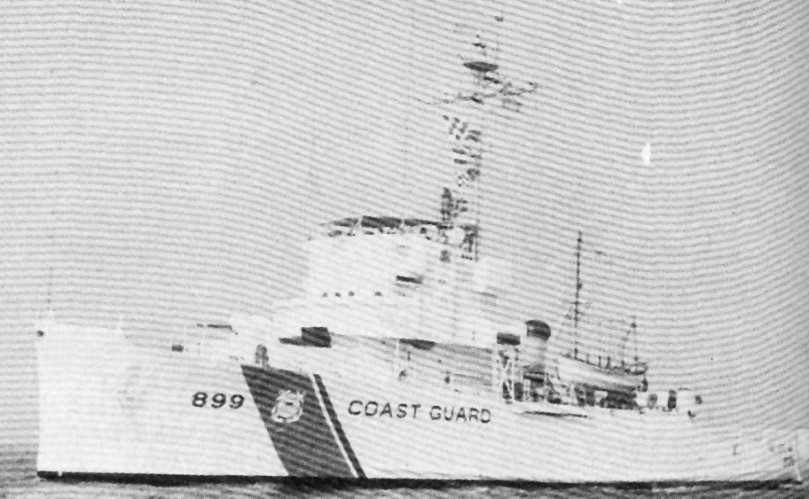
(USCGC Lamar, formerly USS Lamar (PCE-899) during WWII, was the last PCE-842 class in active frontline duty with the American military, decommissioning on 30 September 1969.)
UMS Yan Tuang Aung – the ex-PCE
USS Farmington (PCE-894) was built by Willamette Iron & Steel Company in Portland, OR (the same shipyard which built the future Burmese half-sister USS Creddock). Launched in May 1943, the ship commissioned on 10 August 1944. During WWII USS Farmington operated primarily in the Alaskan theatre.
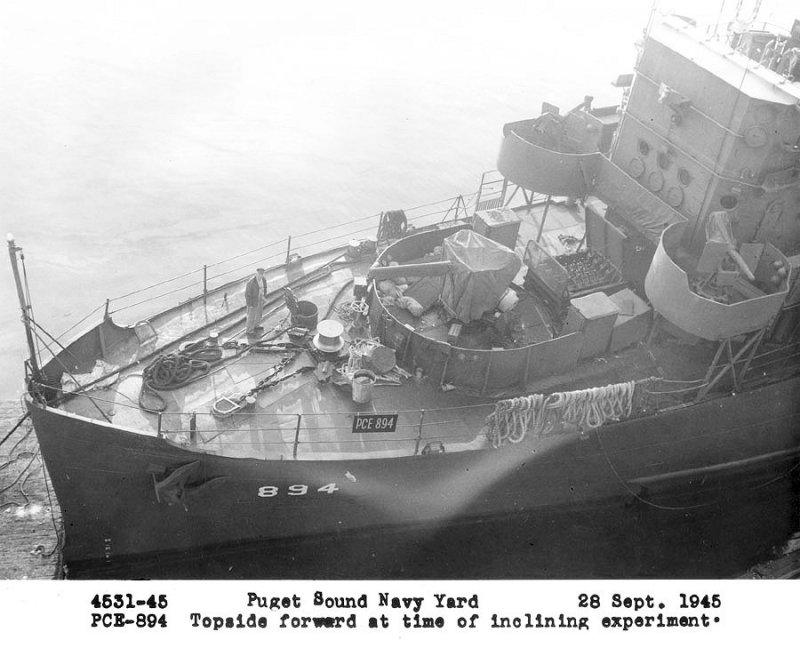
(USS Farmington four weeks after WWII ended. This photo shows the location of the Hedgehog and also the then-single 20mm mounts.)
In August 1947 USS Farmington was assigned to the US Naval Reserve’s 9th District and homeported in Chicago, IL. Here the ship trained weekend reservists from Illinois, Indiana, and Wisconsin on ASW. To this, a railroad tank car was moored to WWII surplus Mk6 mine anchors in Lake Michigan to simulate a submerged submarine.
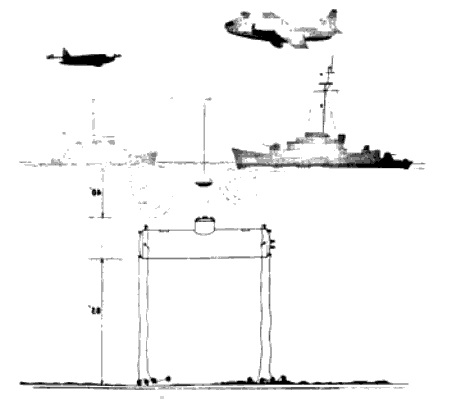
In October 1964 this concluded and USS Farmington was reassigned to the Atlantic Fleet. Unwanted there, USS Farmington decommissioned on 1 December 1964 and was immediately made available for foreign transfer or scrapping.
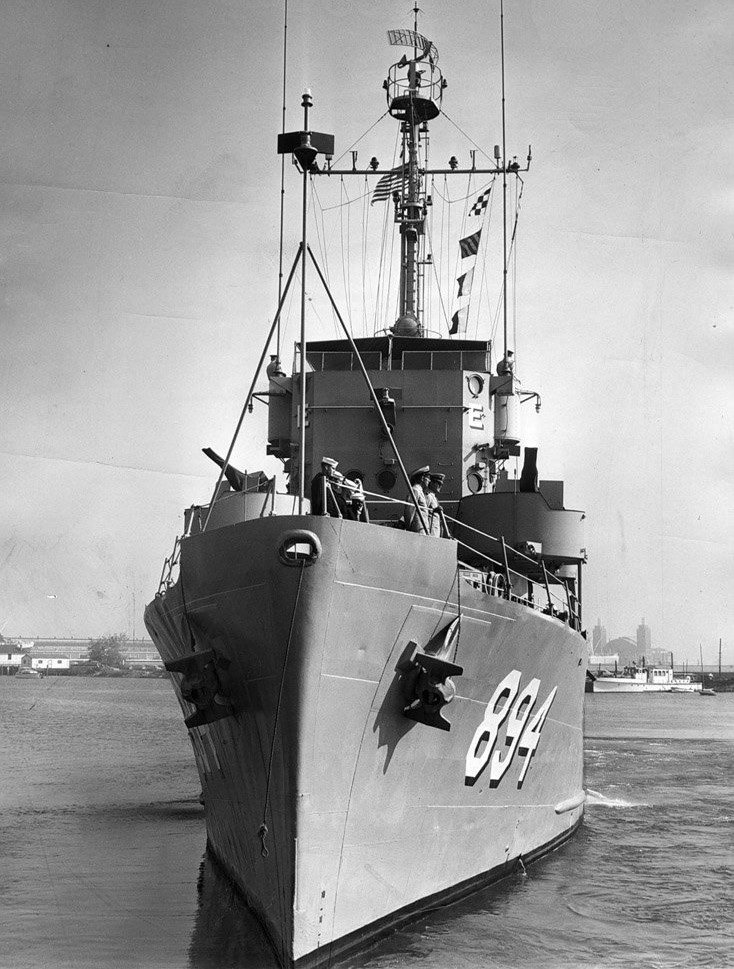
(USS Farmington just prior to the handover to Burma, with AN/SPS-5 having replaced the WWII radar and twin 20mm guns having replaced the singles.)
The Burmese navy had not added any blue-water hulls since the ex-HMS Mariner in 1958 and even with that, had only that ship plus UBS Mayu for open-ocean operations. By the mid-1960s expansion was desired and USS Farmington, whatever the design’s limitations, was a quick, cheap option. On 18 June 1965 the ship was bought as UBS Yan Tuang Aung.
UBS Yan Tuang Aung has General Motors 12-567A diesels and Falk gearings. With this combination (one of the many possible with the PCE-842 design) the ship was rated at 15 kts maximum speed at the time of transfer.
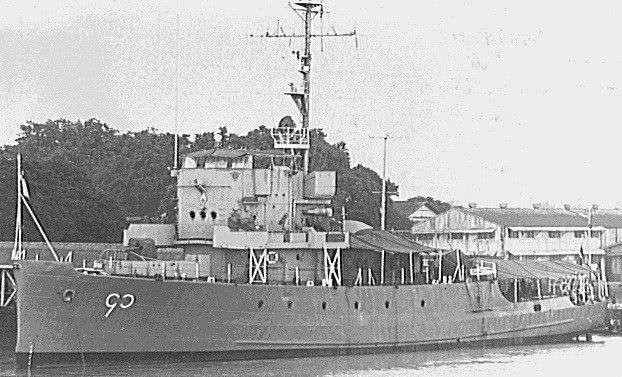
(UBS Yan Tuang Aung in 1987. Over the decades the Burmese / Myanmar navy alternated between western and Burmese numerals for pennant numbers.)
After several years in Burma the AN/QCU-2 sonar was non-operational and permanently deactivated. All of the ASW weapons except the Hedgehog were removed during the late 1970s or early 1980s.
During the 1980s, the AN/SPS-5 became non-operational and was removed and replaced by a civilian navigation radar. Later still, a second civilian navigation radar joined it. During the 1980s or early 1990s, the two aft American 40mm twin mounts were removed and replaced with Bofors L/60 single 40mm guns; essentially the same thing as the twin American gun. At independence the British gifted Burma with some of these AA guns for use both ashore and at sea, and more were bought over the years. Burmese sailors call these guns “dha byet see” (“the broom”) and they are popular weapons, despite being obsolete.
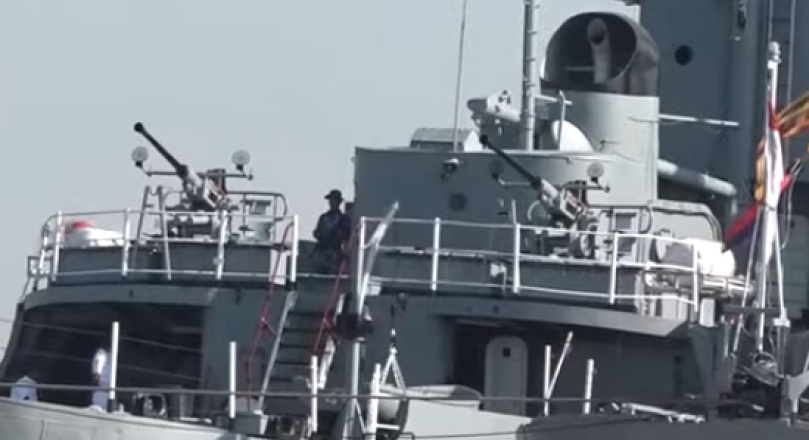
(The Bofors L/60 guns on UMS Yan Tuang Aung.)
UMS Yan Tuang Aung (the prefix being changed to “Union of Myanmar Ship” in 2009) remains otherwise largely unaltered today.
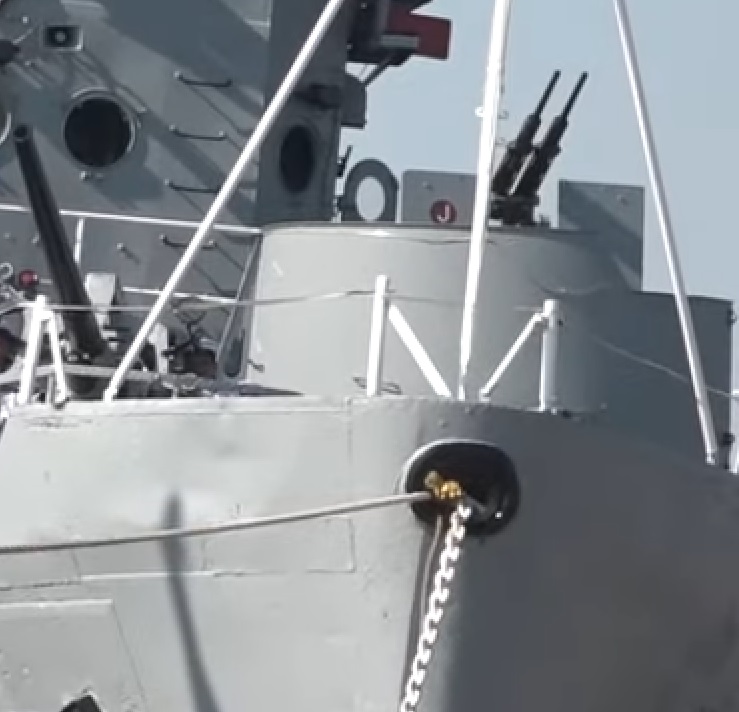
(Detail of the 3″ gun and port 20mm position aboard UMS Yan Tuang Aung during the late 2010s. The “J” is actually a Burmese numeral 2. The Myanmar navy follows US Navy protocol in numbering gun mounts from bow to stern, and even numbers to port side / odd to starboard.)
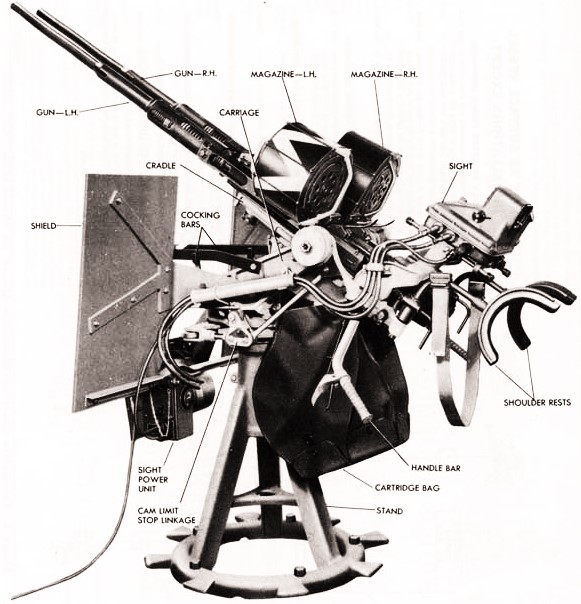
(The Mk24 twin 20mm AA gun from a WWII US Navy manual.)
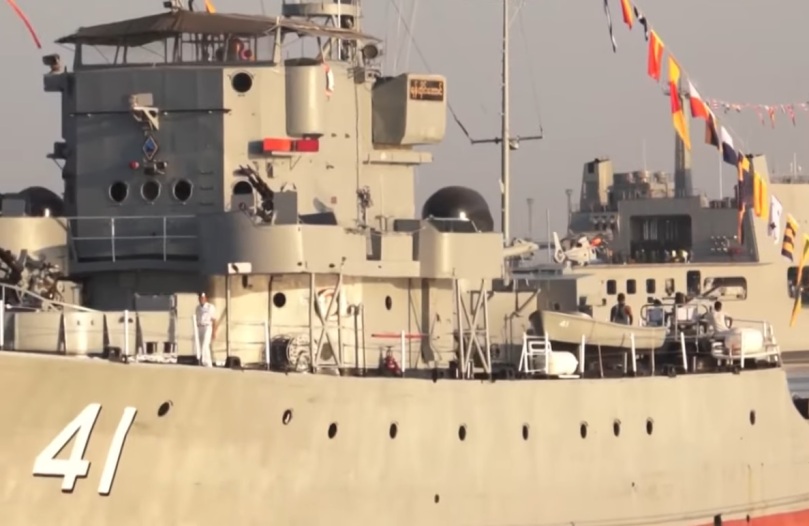
(UMS Yan Tuang Aung in late 2019, largely unaltered from WWII. In the background is the new heavy assault ship UMS Moattama which commissioned in 2019 and one of the navy’s new Z-9 helicopters.)
UMS Yan Gyi Aung – the ex-minesweeper
The WWII history of USS Creddock (MSF-356) isn’t long, because there really isn’t one. The ship was ordered from Willamette Iron & Steel Company in 1943. Work did not start until mid-November and the ship was only ready to be launched in July 1944, whereupon work apparently stopped.
Late in WWII, this was not uncommon. The course of WWII dictated some of this; by mid-1944 amphibious landing craft and destroyers were needed in the Pacific more than minesweepers. As the WWII US Navy ballooned in size, care had to be taken to not only balance new ships with the missions needed, but also to draw from a limited pool of engines, sensors, and weapons common to various classes of different types of warships. There was also a limited bandwidth of trained sailors available for the hundreds of new warships being built. Finally by that point in WWII, many shipyards were at 100% labor capacity.
USS Creddock was finally finished and commissioned on 18 December 1945, 3½ months after WWII had already ended. Sailing to San Diego, CA that month, the ship milled about for a few weeks before decommissioning into mothballs on 26 March 1946.
In 1967 the Burmese navy desired a “partner” for UBS Yan Tuang Aung. On 31 March 1967, the ex-USS Creddock was purchased as UBS Yan Gyi Aung. The ship was reactivated at San Diego, CA and sailed by itself across the Pacific and Indian oceans to Rangoon.
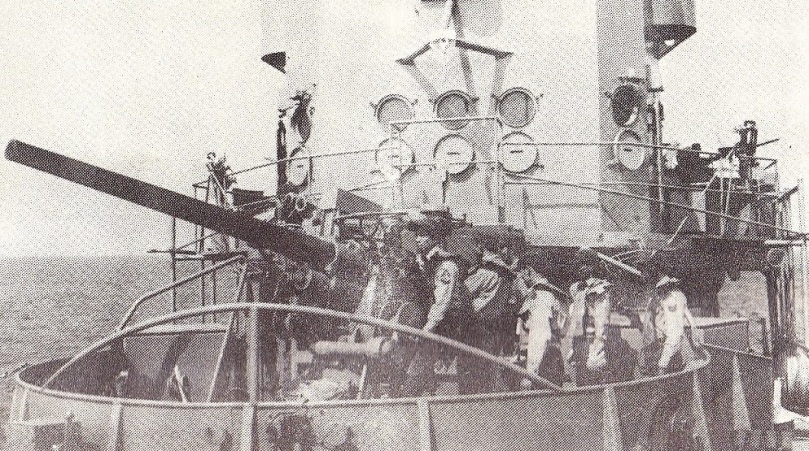
(UBS Yan Gyi Aung conducting gunnery training in the Andaman Sea during the late 1960s.)
Despite superficially being a half-sister to UBS Yan Tuang Aung, UBS Yan Gyi Aung has Busch-Sulzer BS-539 diesels and thus, is not 100% spare parts-interchangeable. When the ex-USS Creddock was transferred the US Navy rated the top speed at 14¾ kts. Prior to sailing for Burma the WWII radar was replaced by a AN/SPS-5 to make the two ships common in that regard.
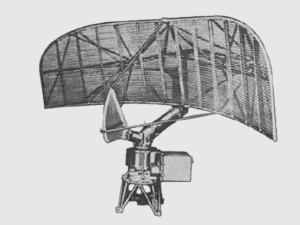
(The G/H-band AN/SPS-5 surface search radar had a range of 30 NM against an aircraft carrier and about 19½ NM against frigates or corvettes. During and after the Korean War, it replaced a number of old radars still aboard warships built during WWII.)
The minesweeping kit was not certain. Some sources state that the WWII paravanes were not taken aboard in San Diego but this would seem unlikely. The Burmese took care to include everything else and initially at least, the Burmese fleet rolls listed UBS Yan Gyi Aung as a minesweeper.
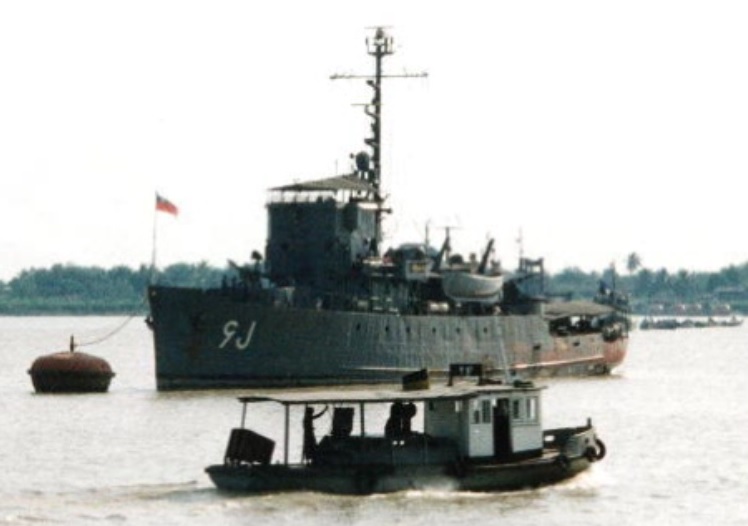
(UBS Yan Gyi Aung in 1991.)
Much like the half-sister, UBS Yan Gyi Aung‘s sonar quickly became inoperable. The minesweeping gear, if it had been aboard at transfer, was removed during the 1980s as was all ASW weaponry. The AN/SPS-5 radar became non-operational and was replaced by a simple civilian navigation radar.
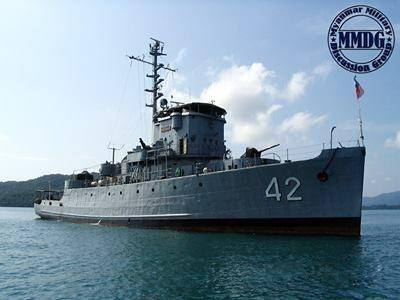
(UMS Yan Gyi Aung in 2013.) (photo via Myanmar Military Discussion Group)
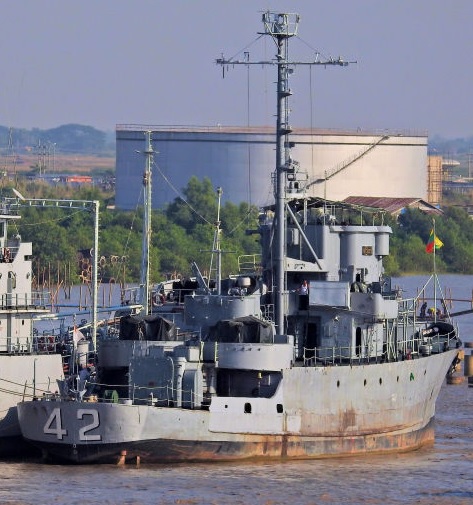
(UMS Yan Gyi Aung in late 2015.) (photo by Brian Fisher)
Otherwise, UMS Yan Gyi Aung is still today remarkably unchanged from the WWII baseline, perhaps even less so than the PCE half-sister.
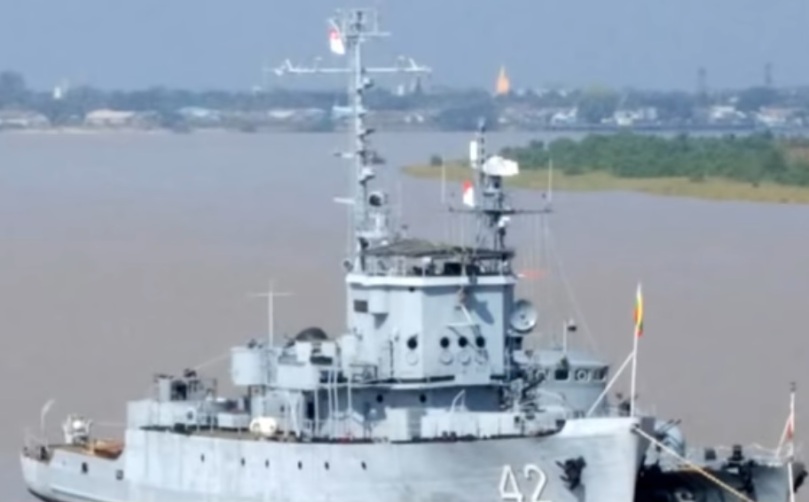
(UMS Yan Gyi Aung in 2016 with a modern corvette alongside.)
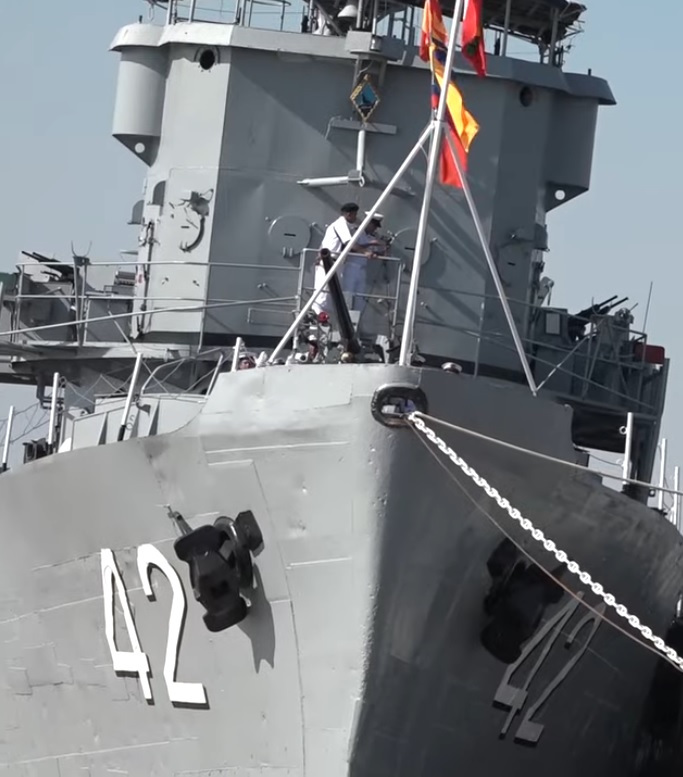
(UMS Yan Gyi Aung in December 2019.)
telling the half-sisters apart
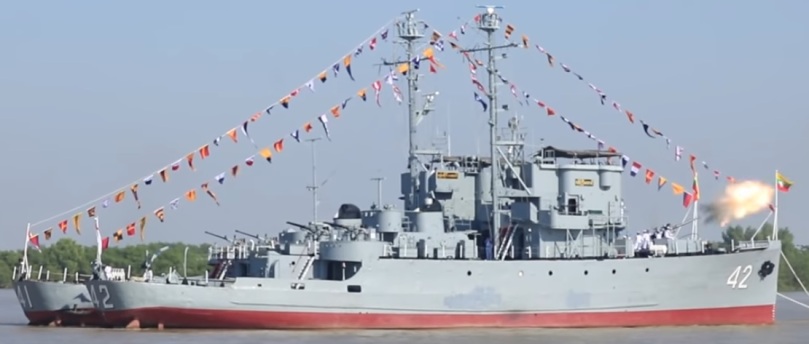
(UMS Yan Tuang Aung – the former PCE – behind UMS Yan Gyi Aung- the former MSF – in December 2019.)
Despite their common origin during WWII and nearly-identical appearance and equipment fit now, there are some differences between these two elderly half-sister ships.
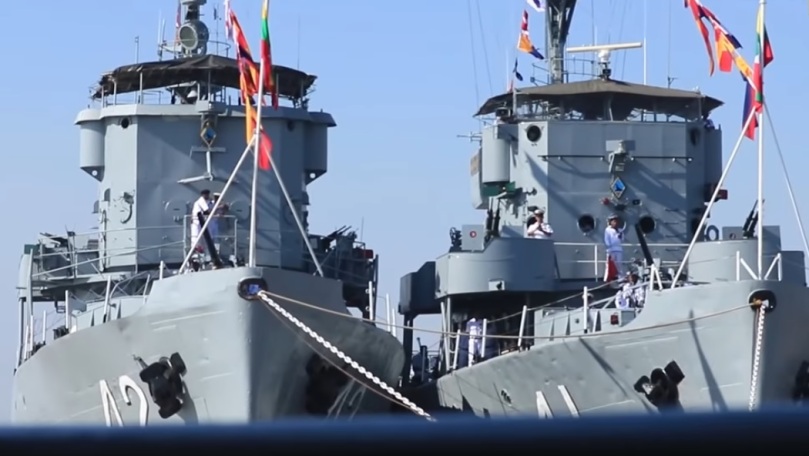
In the above 2019 photo UMS Yan Gyi Aung – 42, the ex-minesweeper – is to the left and has porthole shutters which UMS Yan Tuang Aung – 41, the ex-PCE – on the right lacks. UMS Yan Gyi Aung still has the 24″ US Navy searchlight from WWII while UMS Yan Tuang Aung has a second civilian radar. UMS Yan Gyi Aung has simple platforms for the forward 20mm AA guns while UMS Yan Tuang Aung has tub-like enclosures.
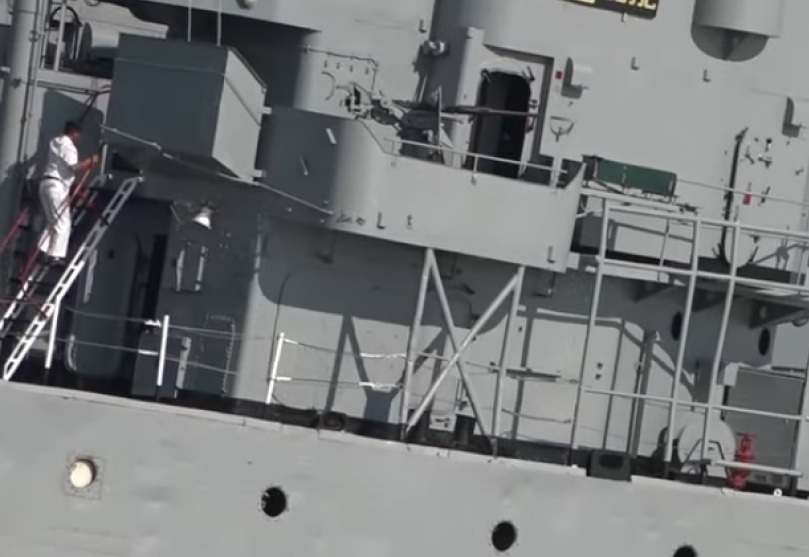
The starboard 20mm position aboard UMS Yan Gyi Aung, the former minesweeper, which is a basic platform set a bit further back than the tubs on UMS Yan Tuang Aung, the ex-PCE.
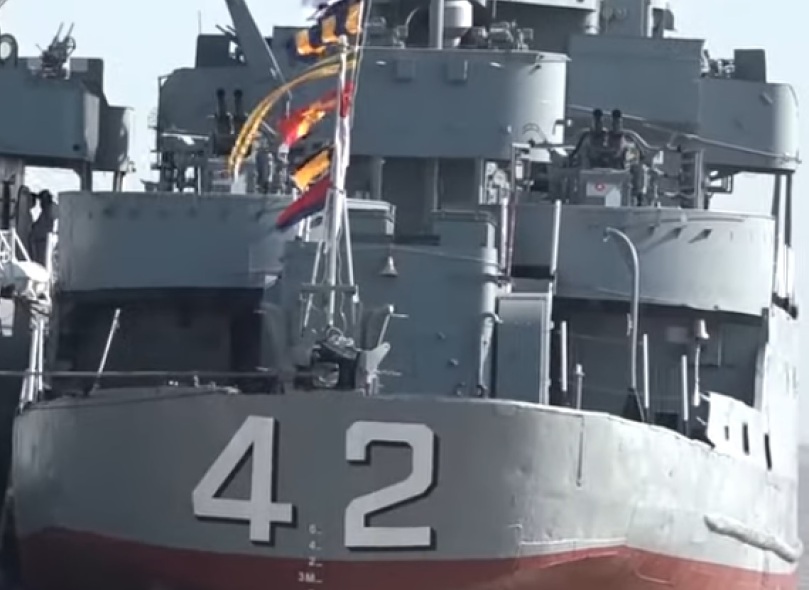
The easiest clue aft is the weapons. UMS Yan Gyi Aung, the ex-minesweeper, has tubs for the WWII-vintage Mk2 twin 40mm guns as seen above while UMS Yan Tuang Aung, the ex-PCE, has open positions for the single 40mm guns as shown earlier. On UMS Yan Gyi Aung the “pulpit” between the two tubs houses two WWII-vintage Mk51 off-mount fire control directors for the 40mm guns as seen above.
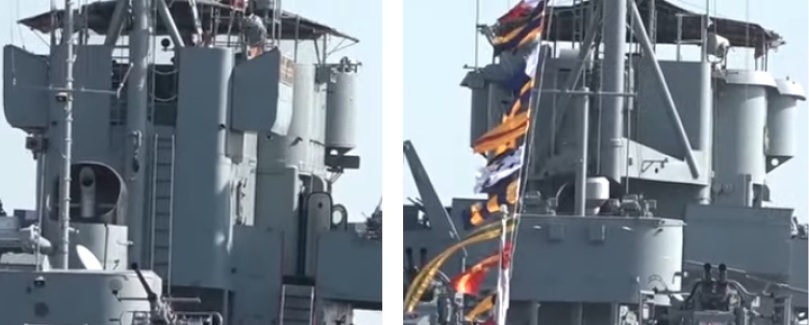
There are differences in the superstructure rear. UMS Yan Tuang Aung, the ex-PCE, has signalman’s boxes on either side of the rear upper bridge which UMS Yan Gyi Aung, the ex-minesweeper, lacks. The mainmast of UMS Yan Tuang Aung is lighter and set on the superstructure, while on UMS Yan Gyi Aung it is a heavier mast with an A-frame brace.
On the above photo is a mildly interesting tidbit. As these two ships are diesel-powered they didn’t really need traditional funnels (smokestacks) but have dummy ones anyways. On UMS Yan Tuang Aung there is just a simple curved exhaust pipe inside, while UMS Yan Gyi Aung has a mushroom cap. Both are only visible dead-astern, being otherwise concealed by the dummy funnel.
how did Myanmar keep these ships going
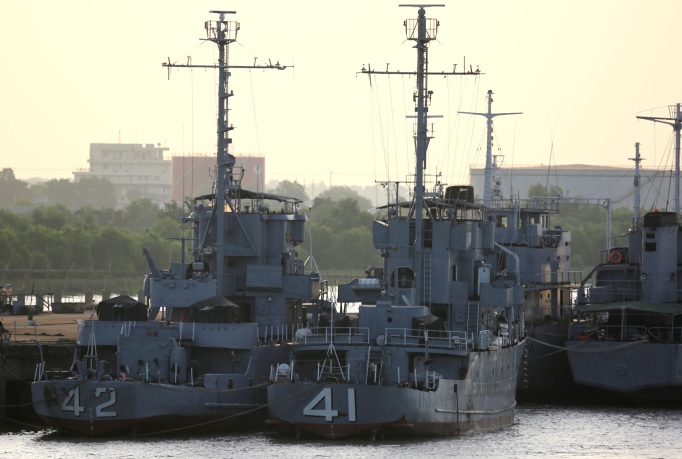
(The two WWII ships on duty in 2017.) (photo by Vladimir Knyaz)
WWII ended 75 years ago and by 2020, these ships have more than tripled their expected maximum lifespans when they were designed in the 1940s. This naturally begs the question, how?
One answer is the most simple…..the water they serve in. Both were assigned to what was then the Burmese navy’s 1st Fleet (today the Myanmar navy’s Yangon Regional Command) and have always been homeported in the Bago or Yangon rivers. Here, flowing freshwater naturally still oxidizes steel somewhat, but corrodes it at a much slower pace than constant saltwater exposure. The Bago river is very muddy and this also acts as a natural algae retardant.
When both still made regular patrols they normally operated in the Tataik Chaung (the huge mouth of the Yangon / Bago river delta into the Andaman Sea) which itself is brackish water.
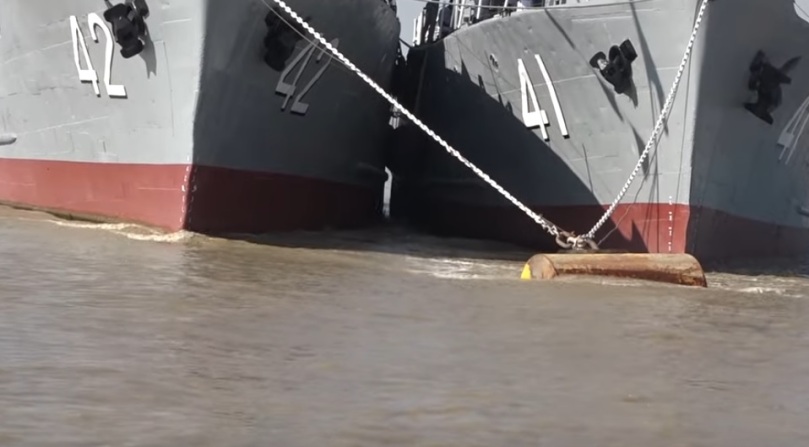
(The current of the Bago river is very strong, here it is creating bow waves on two WWII warships and the mooring buoy in 2019. Note how taut the heavy chain tying up UMS Yan Gyi Aung is pulled.)
Beyond hull conditioning, the answers are harder to come by. Spare parts must have already been a headache for years if not decades. For example the BS-539 diesels powering UMS Yan Gyi Aung were not rare during WWII but not common either. Busch-Sulzer in St. Louis exited the naval engine business several months after V-J Day and the Nordberg Company in Milwaukee ended legacy support in 1970. Several companies, most prominently Hatch & Kirk, did (and to an extent, still do) specialize in sourcing hard-to-find legacy parts for old warships but this is not cheap and furthermore, Burma / Myanmar’s relations with the USA have not always been great since these ships were delivered. Another possibility is several companies in Kaohsiung, Taiwan which discretely re-exported parts taken from WWII-era American warships scrapped in Taiwan during the 1970s and 1980s.
For certain the original WWII engines and gearboxes are still onboard, as re-engining an Admirable or PCE-842 would require cutting off the whole bridge superstructure to access the forward engine room.
The Mk21 3″ guns had a barrel lifespan of between 3,000 – 4,300 firings during WWII. Certainly either figure has been exceeded on these two ships after a half-century in Burma and it is doubtful they were ever re-barrelled. On the other hand, a worn barrel does not make the gun useless, just of declining accuracy as the rifling is shot away. American WWII 3″ naval ammunition circulated widely in southeast Asia during the 1970s, 1980s, and 1990s being also used by Cambodia, South Vietnam, the Philippines, Taiwan, Thailand, South Korea, and Taiwan in the region. It was probably not hard to find.
One last aspect is the Myanmar navy itself. The various military juntas which ruled Myanmar over the decades had atrocious human rights records. But past that, the naval branch has always had very high professionalism. Until recently the Burmese navy didn’t have much, but the sailors did everything they could to take care of what they did have.
the reappearing phantom pair and their future past 2020
These two WWII warships have outlasted various proclamations of their demise, both inside Myanmar and out. In the early 1980s it was reported abroad that both would be discarded, however they were not. In 1994, both were decommissioned into reserve, pending the arrival of two new planned gun frigates. These never materialized and in 1997, both UMS Yan Tuang Aung and UMS Yan Gyi Aung were back in full service. In 2009, it was reported that both were again decommissioned and the normally authoritative Jane’s Fighting Ships omitted them. By early 2011, both were again active.
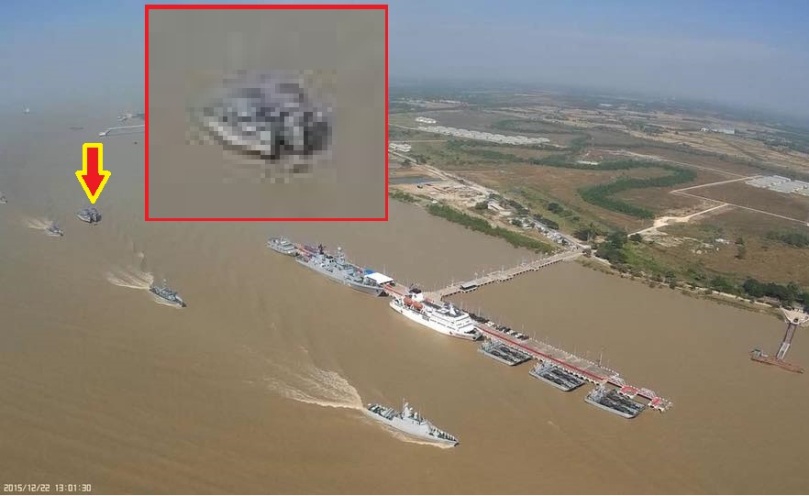
(Both WWII ships visible in 2015.)
Overshadowed by neighboring China’s naval buildup, Myanmar went on a massive naval spending spree adding three corvettes and a frigate in the 2000s; and then two guided missile frigates, two gun frigates, a large amphibious assault ship, four gunboats, three tugboats, two drydocks, and an offshore patrol vessel in the 2010s. The Myanmar navy plans to add a submarine in 2020 or 2021, additional missile frigates by 2025, and a small helicopter carrier by 2030.
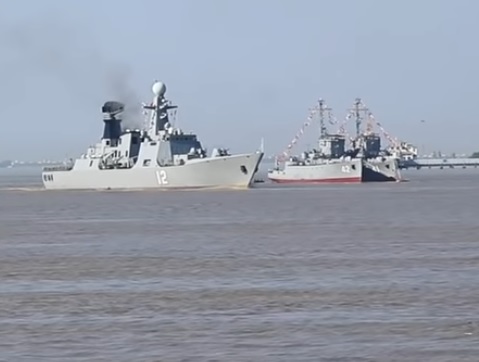
(New and old: the guided missile frigate UMS Kyansitta passes the two WWII warships in 2019.)
It is hard to see these now-ancient relics of WWII fitting into these plans anywhere. In 2020, one Burmese-language source reported that UMS Yan Tuang Aung was being decommisioned but this is not confirmed.
In December 2019, both ships were (externally at least) in excellent condition and fired gun salutes while tied up to a buoy in the Bago river. Neither otherwise participated in the annual naval parade. The last time either was known to have taken an active part in a meaningful naval exercise was in 2014.
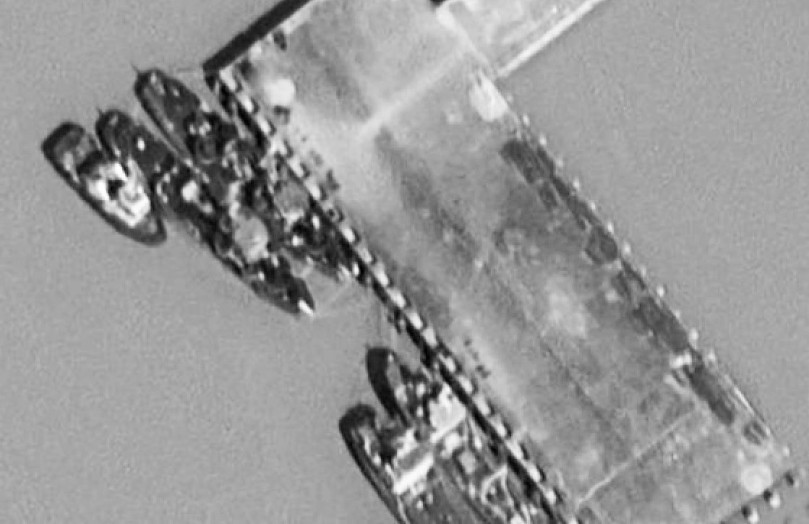
The above image shows both ships shortly after New Years Day 2020, at the “power station pier” about ¾ of a mile downriver from where they were tied up in December 2019. The Myanmar navy uses this quay as a sort of “overflow lot” for the main naval pier on the other side of the new Thilawa Container Port inbetween them. Here UMS Yan Gyi Aung, the ex-minesweeper, is closest to the pier inboard of UMS Yan Tuang Aung and one of the new tugboats.
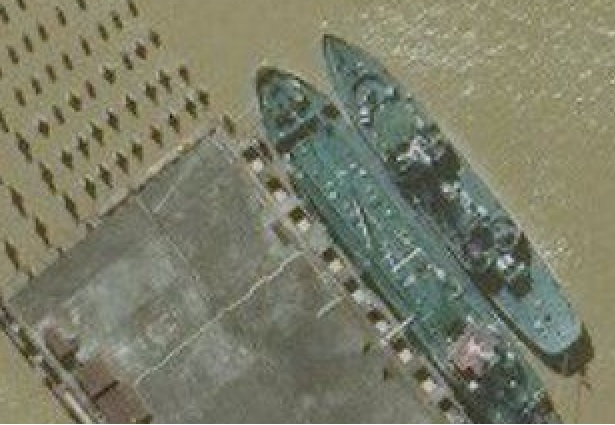
This image is snipped from a Bing Maps look from the summer of 2020. It shows UMS Yan Gyi Aung having moved since January but still at the “power station pier”. UMS Yan Tuang Aung was not to be found and either somewhere else on the Bago river outside of the satellite look, at sea, or perhaps sent off for scrapping.

(The ship’s bell aboard UBS Mayu.)

Shows you how long ships can last when taken care of. USN gets rid of ships at about 20-30 years. With proper paint steel last indefinitely. Most machinery and big diesels can be rebuilt as long as parts are available. But the USN doesn’t spend the time or money on their ships. It’s like planned obsolescence. The ships are in slow decay from the date they’re launched. That’s partially the fault of congress.
LikeLiked by 1 person
The US Navy works their ships much harder than most third world navies that wound up with WW2 surplus. They spend vastly more time at sea in rough conditions and seeing heavy use. An Arleigh Burke might see more use in a year than these ships saw in 50. The same could be said for the decomissioned Spurances and Ticonderogas. It’s hard maintain a ship forever without longer maintenance periods between deployments. Ironically, the USN needs *more ships* to get *more life* out of the ships they have with the commitments they have. Alternatively, they need to cut back on deployments and miles at sea when deployed so they ships they have last longer.
That being said, the decommissioning of the nuclear cruisers in the 90s was a sin. Most of those ships had plenty of life left, though the cost of running them was significant, which played a part in things.
LikeLike
I know the US works its ships hard. I served on destroyers when they were still steam. Before Vietnam was taking all the money, we were at sea 2-3 weeks of the month when at our home port and when in the 7th fleet, at sea 90% of the time. And then there were about a thousand ships. I’ve also worked in yards and owned a small yard. And the amount of money congress gives the navy is part of the problem. But my point was maintain the paint an machinery and you still have a usable ship. Many larger commercial fishing vessels started life as WWII army, CG or navy vessels. Some were widened and lengthened, but taken care of and still going 80 years later. I liveaboard and cruise a 1942 USCG still going.
The navy wasted all that money on the near useless LCS fleet. They wouldn’t make a good fishing boat. Not reliable enough. Had the LCS money gone into the FFGs we had, we could have modernized them for less than building a whole new set.
I think the problem of short ship life is the navy leadership and to a lesser degree some captains. We got a 13 billion carrier that only now is starting to work and we’re building 2 more like it. And then there’s the Zumwalts.
I remember in the yards, 2 sister ships come in, one in great condition and the other a rust bucket with major casualties the crew could have handled. Some caused by poor maintenance.
I’m with you on the cruisers. If we still had a naval reserve, the Sprunces would have made the best reserve destroyers since WWII. I don’t know why the leadership couldn’t see the Chinese problem coming. When the Sprunces decommissioned, China was building military forces faster than Hitler prior to WWII. I saw it, maybe you did too.
LikeLike
“With proper paint steel last indefinitely.”
True. However, their combat capacity continues to degrade. The USN has lots of ships that make it past 30 years of service; they just aren’t in the battle fleet.
LikeLike
Weapon systems, radar can be upgraded and so on. It’s usually cheaper to rebuild/upgrade than build a whole new ship. Seems to me carriers are going 50 years now. I’d call that #1 in the battle fleet. If they’re going to keep the cruisers we have now, the youngest is 28 years. They’re only 1200 tons more than a Burke’s 8400 tons. WWII heavy cruisers were 15,000+. Maybe we’ll see the end of cruisers in the USN.
LikeLiked by 1 person
The USN basically said last year that there was not going to be another American cruiser built; with the “Super-Burke” taking over that role.
LikeLike
Reblogged this on Dave Loves History.
LikeLike
Both UMS Yan Gyi Aung and UMS Yan Taing Aung are using only in
Navy Davy Ships Commisioning Ceremony.They are not decommisioned yet.But they are using for gun firing in
Ceremony.
LikeLiked by 1 person
This article mentions that UBS Mayu had her aft 4 in. gun removed and replaced by a helicopter deck sometime during the early 1970s.. This modernization did not take place in the 1970s. I have a 1962/63 Jane’s Fighting Ships and there is a photo of UBS Mayu in there taken in 1960. In this 1960 photo, Mayu already had this modernization with a aft helicopter deck. It’s very likely that UBS Mayu had this modernization sometime in the late 1950s.
LikeLike
Hi Brian, thanks for the info. I dont doubt that the aft gun may have been removed at that time but I dont believe the helipad mod was done. Burma didnt have any helicopters at all until 1959 when their air force got a dozen Bell 47s. I dont believe they would have done an extensive rebuild before they even had helicopters in the country, let alone in the navy. But you may be correct. BTW I collect old Jane’s Fighting Ships too; it is always a treat to see one at a library rummage or whatever. I got one from the early 1970s for $1 once!
LikeLike
Thanks for the response. Well I am sure this hello pad was done at least by the year 1960. It is very clearly on the ship in my 1962 Jane’s photo.
LikeLike
Fascinating stuff!
As a PCE sailor myself, I would love to see you make another article on WWII warships still in Philippine’s navy!
Wish we could bring one home.
LikeLiked by 1 person
[…] WWII warships still in Myanmar’s navy — wwiiafterwwii […]
LikeLike